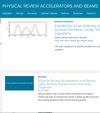加速器驱动散裂中子源的基准屏蔽模拟
Physical Review Special Topics-accelerators and Beams
Pub Date : 2015-08-19
DOI:10.1103/PHYSREVSTAB.18.083501
引用次数: 8
摘要
加速器驱动散裂中子设施的屏蔽对中子散射仪器的性能、整体安全性和设施的总成本起着至关重要的作用。因此,屏蔽组件的精确模拟对于即将到来的设施的设计至关重要,例如目前正在瑞典隆德建造的欧洲散裂源(ESS)。在本文中,我们提出了在瑞士维利根Paul Scherrer研究所(PSI)的瑞士散裂中子源(SINQ)测量和模拟中子背景的比较研究。利用中子剂量计WENDI-2沿着SINQ整体壁的几个位置进行了测量,该中子剂量计具有良好的特征响应,最高可达5 GeV。模拟是使用蒙特卡罗辐射传输代码Geant4进行的,并且在一次计算中包含了从质子束到测量位置的完整传输。在测量的辐射剂量高于背景水平的点上,测量值与模拟值之间的一致性约为2倍,这对于这种跨越许多能量体系、不同物理过程和通过几米屏蔽材料传输的模拟来说是令人满意的结果。对辐射场有贡献的中子来自于靶区的能量大于1兆电子伏特的中子。目前的工作验证了Geant4非常适合于基于加速器的散裂源的深屏蔽计算。我们还推断了模拟的通量水平对ESS的短(几十米)仪器可能意味着什么。本文章由计算机程序翻译,如有差异,请以英文原文为准。
Benchmarking shielding simulations for an accelerator-driven spallation neutron source
The shielding at an accelerator-driven spallation neutron facility plays a critical role in the performance of the neutron scattering instruments, the overall safety, and the total cost of the facility. Accurate simulation of shielding components is thus key for the design of upcoming facilities, such as the European Spallation Source (ESS), currently in construction in Lund, Sweden. In this paper, we present a comparative study between the measured and the simulated neutron background at the Swiss Spallation Neutron Source (SINQ), at the Paul Scherrer Institute (PSI), Villigen, Switzerland. The measurements were carried out at several positions along the SINQ monolith wall with the neutron dosimeter WENDI-2, which has a well-characterized response up to 5 GeV. The simulations were performed using the Monte-Carlo radiation transport code Geant4, and include a complete transport from the proton beam to the measurement locations in a single calculation. An agreement between measurements and simulations is about a factor of 2 for the points where the measured radiation dose is above the background level, which is a satisfactory result for such simulations spanning many energy regimes, different physics processes and transport through several meters of shielding materials. The neutrons contributing to the radiation field emanating from the monolith were confirmed to originate from neutrons with energies above 1 MeV in the target region. The current work validates Geant4 as being well suited for deep-shielding calculations at accelerator-based spallation sources. We also extrapolate what the simulated flux levels might imply for short (several tens of meters) instruments at ESS.
求助全文
通过发布文献求助,成功后即可免费获取论文全文。
去求助
来源期刊
自引率
0.00%
发文量
0
审稿时长
3-8 weeks
期刊介绍:
Physical Review Special Topics - Accelerators and Beams (PRST-AB), is a peer reviewed, purely electronic journal, distributed without charge to readers and funded by contributions from national laboratories. It covers the full range of accelerator science and technology: subsystem and component technologies, beam dynamics; accelerator applications; and design, operation, and improvement of accelerators used in science and industry. This includes accelerators for high-energy and nuclear physics, synchrotron radiation production, spallation neutron sources, medical therapy, and intense beam applications.

 求助内容:
求助内容: 应助结果提醒方式:
应助结果提醒方式:


